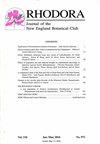Specimen Collection and Preparation for a Changing Flora
IF 0.2
4区 生物学
Q4 PLANT SCIENCES
引用次数: 1
Abstract
Efforts in recent years to digitize herbarium collections (i.e., image, capture label data, and georeference) have allowed for easier access to plant specimen data, facilitating study of the dynamic nature of our world’s flora (Hedrick et al. 2020). In the United States, such studies are increasingly important in light of urbanization and associated habitat destruction, changes in land use, introduction of nonnative species, and climate change. Changes in the flora have economic as well as ecological effects, since habitat loss can affect water quality, wildlife populations, and other landscape attributes important in recreation and tourism (e.g., hiking, fishing). Documenting the flora provides an important tool for understanding historic trends, and those historic “snapshots” of the flora over time can be used in future projects such as habitat mitigation and species restoration. New, well-prepared herbarium specimens, along with thorough collection data, will be valuable additions in the future, providing modern records of distribution and phenology, as well as verifiable records of rare and nonnative species. Traditionally, herbarium specimens have been used in systematics research as well as studies of floristic diversity and biogeography. Specimen data have also been used in making historical comparisons related to ecological succession and human effects such as habitat destruction and climate change (Lang et al. 2018). Assessing changes in phenology, diversity, and distribution over time, tracking introduced and invasive species, and monitoring the decline of rare or sensitive species are common themes in studies making use of herbarium specimens today (Dolan et al. 2011; Everill et al. 2014; Loarie et al. 2008; Primack and Miller-Rushing 2012; Willis et al. 2017). More recently, herbaria have been used to track correlations among taxonomic groups, such as pollinator networks (Mathiasson and Rehan 2020) and mycorrhizal associations (Heberling and Burke 2019). As well, floristics is increasingly being merged into species distribution modeling as a way to use data to identify potential habitat and predict future distributions (Loarie et al. 2008; Wershow and DeChaine 2018), and into spatial phylogenetics, an evolutionary approach to the assessment of biodiversity and endemism (Mishler et al. 2020; Thornhill et al. 2016). Digitization advancements have also paved the way for new initiatives such as the Extended Specimen Network (Lendemer et al. 2020). This concept recognizes that herbarium specimens may be analyzed in multiple ways, creating a suite of interconnected不断变化的植物区系的标本收集和准备
近年来,植物标本馆藏品数字化的努力(即图像、捕获标签数据和地理参考)使人们更容易获取植物标本数据,从而促进了对我们世界植物群动态性质的研究(Hedrick等人,2020)。在美国,鉴于城市化和相关的栖息地破坏、土地利用的变化、外来物种的引入和气候变化,此类研究越来越重要。植物群的变化具有经济和生态影响,因为栖息地的丧失会影响水质、野生动物种群以及其他在娱乐和旅游中重要的景观属性(如徒步旅行、捕鱼)。记录植物群为了解历史趋势提供了一个重要工具,这些植物群随时间的历史“快照”可以用于未来的项目,如栖息地缓解和物种恢复。新的、准备充分的植物标本馆标本,以及全面的收集数据,将是未来有价值的补充,提供分布和酚学的现代记录,以及稀有和非本地物种的可验证记录。传统上,植物标本馆标本被用于系统学研究以及植物区系多样性和生物地理学研究。样本数据也被用于进行与生态演替和人类影响(如栖息地破坏和气候变化)相关的历史比较(Lang等人,2018)。在今天利用植物标本馆标本进行的研究中,评估一段时间内酚类、多样性和分布的变化,跟踪引入物种和入侵物种,以及监测稀有或敏感物种的减少是常见的主题(Dolan等人,2011;Everill等人2014;Loarie等人2008;Primack和Miller Rushing 2012;Willis等人2017)。最近,草药库已被用于跟踪分类群之间的相关性,如传粉昆虫网络(Mathiasson和Rehan 2020)和菌根协会(Heberling和Burke 2019)。此外,植物区系学越来越多地被纳入物种分布建模,作为一种利用数据识别潜在栖息地和预测未来分布的方式(Loarie等人,2008;Wershow和DeChaine,2018),以及空间系统发育学,一种评估生物多样性和地方性的进化方法(Mishler等人,2020;Thornhill等人,2016)。数字化的进步也为扩展样本网络等新举措铺平了道路(Lendemer等人,2020)。这一概念认识到,植物标本馆的标本可以通过多种方式进行分析,形成一套相互关联的
本文章由计算机程序翻译,如有差异,请以英文原文为准。
求助全文
约1分钟内获得全文
求助全文
来源期刊

Rhodora
生物-植物科学
CiteScore
0.40
自引率
0.00%
发文量
40
审稿时长
>12 weeks
期刊介绍:
This peer-reviewed journal is devoted primarily to the botany of North America and accepts scientific papers and notes relating to the systematics, floristics, ecology, paleobotany, or conservation biology of this or floristically related regions.
 求助内容:
求助内容: 应助结果提醒方式:
应助结果提醒方式:


